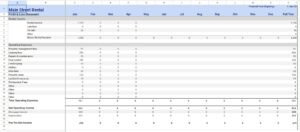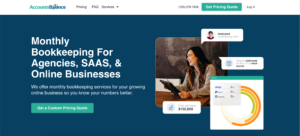As a business owner, you are working to achieve a sustainable business model, one that generates profits over time. However, to know if your business is profitable or not, understanding your financial statements is critical. For Profit and Loss Statement (P&L) for a Rental Property, your P&L statement will follow a similar format to a normal P&L, but there are a few key differences to keep in mind.

What is a Profit and Loss Statement for Rental Property?
A profit and loss statement for rental property is used by owners and property managers to track income and expenses, along with the corresponding profits or losses. A rental property P&L statement reports the current financial performance of a property over a specific period.
It can also help to identify potential opportunities to increase income, reduce expenses, and maximize net operating income (NOI). As a landlord, your real estate is a capital expenditure, but unlike a business that produces products, your rental properties are the product. Let’s dive into the components of a P&L statement for rental properties.
Components of a Profit and Loss Statement
Your rental property P&L statement is divided into three key sections:
- Gross income
- Operating expenses
- Net operating income (NOI)
Let’s dive into what each of those involves and how it plays a role in developing an accurate P&L statement for your company.
Gross Rental Income
Gross income includes all the revenue from your monthly rent collections. Other items in this category are your income from pet rent, appliance rent, and revenues from parking and the laundry room. Application fees and late fees are also part of your gross income. Gross income is recorded and assigned to a specific line item based upon how your rental property chart of accounts is set up. By itemizing your revenue streams, you can have a better understanding of how your properties are making money, as well as identify opportunities to increase your income.
Operating Expenses
The operating expenses include all the costs and expenses of owning and operating rental real estate. Usually, these expenses are assigned to a specific line item based on each type of expense.
As a real estate owner and investor, you recognize that different property types of different operating expenses. After all, a multifamily property might have utilities paid by the owner for common areas, but a manufacturing facility might not have those same expenses. In a single-family home rental, tenants pay all the utilities, which would end up meaning that you wouldn’t have that expense as a line item.
Common operating expenses found on a profit and loss statement include:
- Advertising and marketing
- Bank fees
- Continuing education
- Depreciation expense
- Dues and subscriptions
- HOA fees
- Interest – mortgage/business credit cards
- Landlord insurance
- Leasing fees
- Licenses and permits
- Maintenance fees
- Mortgage payments
- Office supplies
- Owner auto expense
- Pest control
- Professional fees
- Taxes – Property/Sales
- Property management fees
- Repairs
- Trash removal
Your operating expense section of your P&L can be modeled after Schedule E from the IRS.
Net Operating Income
Net operating income tells real estate investors how much a given property makes on a weekly, monthly, or yearly basis. To figure it out, you need to follow this formula:
Total income – Total operating expenses = Net operating income
Real estate investors use net operating income (NOI) in financial calculations to determine the cap rate and debt service coverage ratio (DSCR). The cap rate reveals the current and potential return of your rental, while the DSCR determines the mortgage amount your property’s net operating income can support.
Before you calculate your cap rate and DSCR, remove the mortgage payment, mortgage interest, depreciation, and capital expenses from the total operating expenses to keep your NOI accurate. Investors are using the NOI to determine if any specific investment can generate income to cover debt payments.
Keep in mind that most of your expenses are fixed, so if you are smart in how you manage them, you can keep a property profitable. Another way to improve profitability is to reduce expenses or transition expenses to your renters. For instance, if your older properties have central heating, investing in changing it to separately metered heat is a way to reduce your utility expenses and increase the profitability of your rentals.
The goal is to learn how your income and expenses for each property to determine how you can improve the overall profitability of your rental portfolio.

Rental Property Profit and Loss Template
A basic rental property profit and loss template can be created with your accounting software. With a template in place, you can customize it to reflect the financial information for each property or the portfolio as a whole.
Example of a Rental Property Profit and Loss Statement

Types of Rental Property Profit and Loss Statements
There are several types of profit and loss statements for real estate, based upon the different periods you would like to analyze. Below are some of the common P&L statements.
Monthly Income Expense Statement
The monthly income expense statement tracks the expenses and income for a rental property or portfolio across one month. You can use this to compare expenses across months or even in comparable months from one year to the next. This type of P&L can also assist you in determining which seasons have the highest expenses.
Year-to-Date (YTD)
A year-to-date P&L will give you the data regarding your income and expenses for your properties to that point in the year. This can also highlight if certain properties have higher expenses than others and what the potential causes of that might be.
Year-End
This report summarizes the financial performance of a property over the course of a year and can be used by owners and property managers to track income, expenses, and the property’s profitability. You can also use these reports to analyze expenses and income from one year to the next and highlight potential issues.

Trailing 12 Months (T-12 Statement)
A trailing 12-month statement looks at the previous 12 months of data for your rental properties and allows you to analyze a year’s worth of financial data at any point of the year. Unlike a year-to-date, which only includes the financial information from January 1st until the day you run the report, a T-12 statement can give you an accurate view of your company’s financial health right now.
Frequently Asked Questions
How do you calculate profit and loss on an investment property?
To calculate your profit and loss statement for a rental property, you need all the income streams for that property and the operating expenses. Once you subtract your operating expenses from the total income, you will get your bottom line or NOI for the property.
What is a real estate income statement?
This is a financial report that lists income and expenses from a property over a specific period. It is one of the three key financial reports real estate investors use to monitor the performance of rental properties, both those owned and prospective investment properties.
Does property go on the income statement?
Yes, but the report should break down your portfolio by property and show total operating expenses and gross income to highlight total profits. Information on a real estate income statement can include gross rental income, additional income, operating expenses, insurance premiums, property tax payments, mortgage interest, and net operating income.
Can accounting software help you manage income statements and balance sheets?
Accounting software can allow you to run your P&L statements for specific dates, giving you the ability to do deeper analysis of your portfolio’s profitability. Plus, you can also generate reports based on each specific property, with the data filled in by your accounting software.
What are the 5 types of financial statements?
Balance sheet, income statement, statement of cash flows, statement of shareholder’s equity, and footnotes to financial statements
What Is AccountsBalance?

AccountsBalance is a monthly bookkeeping service specialized for agencies & SAAS companies.
We take monthly bookkeeping off your plate and deliver you your financial statements by the 15th or 20th of each month.
You’ll have your Profit and Loss Statement, Balance Sheet, and Cash Flow Statement ready for analysis each month so you and your business partners can make better business decisions.
Interested in learning more? Schedule a call with our CEO, Nathan Hirsch.
And here’s some free resources:
In Summary
While real estate investment doesn’t have the same income streams and operating expenses that other business models might, you can still create a profit and loss statement. The P&L gives you the ability to determine whether a property is profitable or not, thus helping you to determine the best investment strategy for your portfolio.









